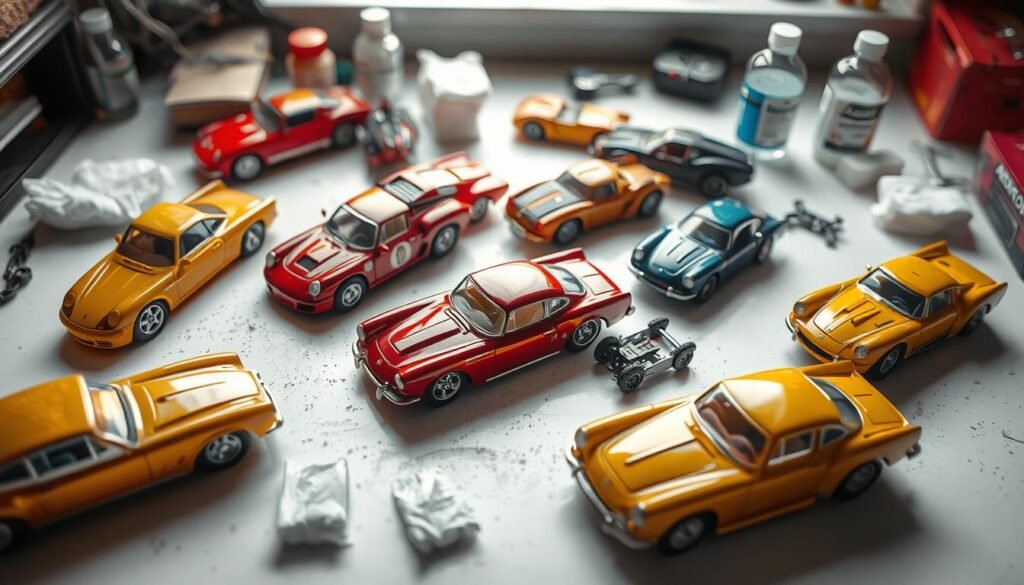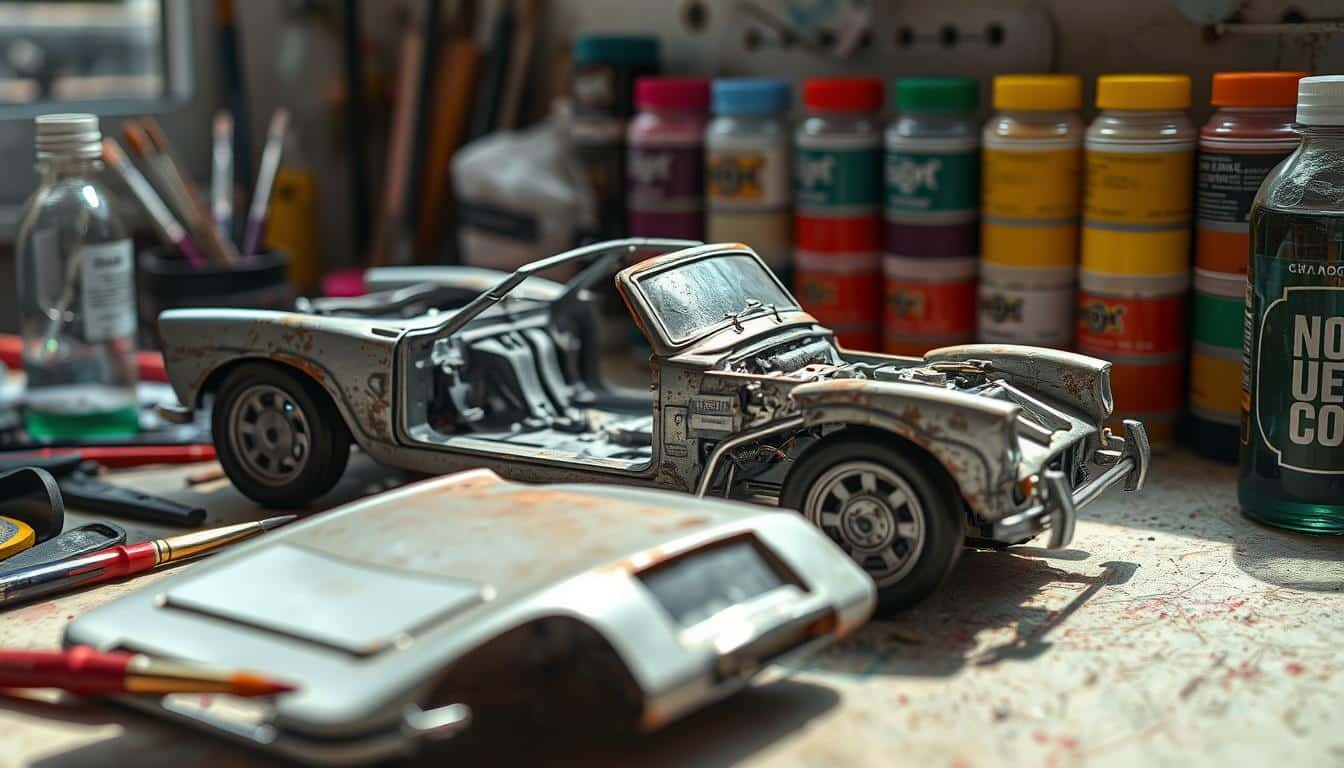Restoring diecast car models often involves using acetone. This solvent is popular for stripping paint and removing decals. But, its safety and effectiveness are debated. So, is using acetone on diecast cars safe, or could it damage your collection?
Key Takeaways
- Acetone is a commonly used solvent for stripping paint from diecast cars, but it poses risks to plastic components.
- Safety precautions are crucial when working with acetone, including protective gear and adequate ventilation.
- Alternatives like brake fluid, Pine-Sol, and commercial paint strippers are available as safer options for diecast car restoration.
- The choice of paint removal method depends on the specific model and desired outcome.
- Understanding the chemical properties of acetone and how it interacts with different paint types is essential for successful and safe diecast car restoration.
Understanding Acetone and Its Effects on Diecast Models
Acetone is a strong solvent that can remove paint from diecast cars. It works well with different paints but needs careful use. Knowing how acetone affects your diecast models is key.
Chemical Properties of Acetone
Acetone is flammable, volatile, and colorless. It dissolves plastics, rubbers, and coatings. Its low boiling point and fast evaporation make it useful but also require safety.
How Acetone Interacts with Different Paint Types
Acetone’s effect on paint varies. Lacquer-based paints come off quickly. Enamel or acrylic paints need more time. Knowing your model’s paint is crucial for safe removal.
Safety Considerations and Precautions
Using acetone safely is important. It’s toxic when inhaled and can harm plastics. Work in a well-ventilated area, wear gloves and eyewear, and avoid heat. It can dry out your skin, so be careful.
| AEGL Level | Exposure Duration | Potential Effects |
|---|---|---|
| AEGL-1 | 10 minutes to 8 hours | Notable discomfort and transient, reversible effects |
| AEGL-2 | 10 minutes to 8 hours | Irreversible or serious, long-lasting adverse health effects |
| AEGL-3 | 10 minutes to 8 hours | Life-threatening health effects or death |
Understanding acetone’s properties and safety is key. This knowledge helps you use it safely for painting, diecast car maintenance, and using solvents on collectibles.
Can You Use Acetone on Diecast Cars: Methods and Applications

Acetone, or nail polish remover, is often debated for cleaning diecast cars. It can remove paint from metal toys but needs careful use. This is to avoid harming plastic parts or the paint underneath.
To safely use acetone, take apart the diecast car. Remove any plastic parts and soak the metal in a jar with a metal lid. The paint should peel off quickly, but tough spots might need extra effort. The best part is, acetone dries completely, leaving no mess for repainting.
But, using acetone on diecast cars requires caution. It can harm plastic parts like windshields. So, remove these before treatment. Also, the fumes can be dangerous, so work in a well-ventilated area and wear protective gear.
For a safer option, consider non-acetone nail polish removers for diecast car detailing. These are usually pink and gentler on plastics. Still, work in small areas to avoid damaging the paint underneath.
Choosing the right method is key for removing paint from collectibles safely. With the right steps, diecast car fans can restore their treasures without harm.
Alternative Paint Stripping Solutions for Diecast Cars
If you want to fix up your diecast car collection, you might think of using acetone. But, acetone can be too harsh and might damage the paint or soften the plastic. Luckily, there are safer and better ways to strip paint from your models.
Brake Fluid Method
Brake fluid is a safer choice. It won’t hurt most plastics, which is why many model railroaders use it. Soaking the diecast car in brake fluid can take up to 24 hours to show results.
Pine-Sol and Household Solutions
Using Pine-Sol is another good option. It can strip paint when left to soak overnight. But, how well it works depends on the paint and model. You can also try baking soda or vinegar for safe paint removal.
Commercial Paint Strippers
For a more precise method, try commercial paint strippers made for diecast cars. Biostrip 20 works well on metals and enamel paints. You can also find aerosol strippers at Walmart or Dumond Smart Strip for safe removal.
When restoring your model cars, it’s key to find safe paint stripping methods. The right choice helps remove old paint and gets your cars looking new again. This way, you avoid damaging the materials underneath.
Conclusion
Choosing the right paint removal method for your diecast car is key. Acetone is popular but needs careful handling. Other options like brake fluid, Pine-Sol, and commercial strippers have their own risks and benefits.
Deciding on a method should involve research and understanding the risks. Always prioritize safety with protective gear and a well-ventilated area. By trying different techniques, you can find the safest way to restore your diecast car.
The diecast car community is full of helpful tips and techniques. Use this resource to learn about safe restoration methods. With the right approach, your diecast collection will look great for years.
FAQ
Can I use acetone on my diecast cars?
What are the risks of using acetone on diecast cars?
How do I use acetone to strip paint from diecast cars?
Are there any safer alternatives to acetone for stripping paint from diecast cars?
Source Links
- removing paint from diecast car? – https://www.hobbytalk.com/threads/removing-paint-from-diecast-car.88531/
- Stripping Dinky Toys Diecasts Advice Needed – https://leadadventureforum.com/index.php?topic=141710.0
- Removing unwanted tampo printing – DA.C – https://www.diecastaircraftforum.com/1-200-scale-model-aircraft/293465-removing-unwanted-tampo-printing.html
- Acetone Interim AEGL Document – https://www.epa.gov/sites/default/files/2014-07/documents/tsd200.pdf
- Automated Ultrasonic Misting 3D Print Polisher PRO – https://www.instructables.com/Automated-Ultrasonic-Misting-3D-Print-Polisher-PRO/
- Removing Tampos from models (Guide) – https://www.diecastxchange.com/threads/removing-tampos-from-models-guide.30619/
- dakka modeling faq: how to strip… – Articles – https://www.dakkadakka.com/wiki/en/dakka_modeling_faq:_how_to_strip…
- Can Nail Polish Remover Be Used On Plastic Model Cars? – https://daringlily.com/blogs/ask-about-nail-art/can-nail-polish-remover-be-used-on-plastic-model-cars?srsltid=AfmBOopP9Lmr9AZv9i95KlCkJD2tm-76IggTLTio_UAhWMGehEAnp_gy
- Removal of Decal on Diecast… – https://www.diecastaircraftforum.com/military-model-aircraft/157729-removal-decal-diecast.html
- Paint Stripping Brake Fluid vs Blacksmiths Vinegar mixture – https://www.planetdiecast.com/index.php?option=com_kunena&func=view&catid=123&id=31808&Itemid=0
- Diecast Repair Information and Diecast Tips. – http://www.jsssoftware.com/aspx/diecast_tips.aspx
- Acetone in gasoline and surface tension – https://www.physicsforums.com/threads/acetone-in-gasoline-and-surface-tension.195647/







